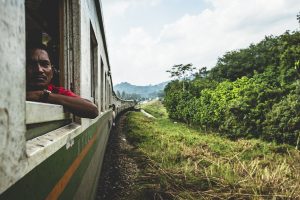Thailand’s insurgency express is a colorful, aging, and rickety train that winds its way across the country’s southern provinces of Songkhla, Pattani, Yala, and Narathiwat. Beginning in Hat Yai, the economic capital of the South, the train ends its journey in Sungai Golok, a neon-soaked red-light town and smuggling center on the Malaysian border.
Since 2004, a brutal separatist insurgency has plagued these same provinces, making the train a recurring target for the Barisan Revolusi Nasional (BRN), an armed group that is fighting for an independent homeland for the southern provinces’ Malay-Muslim majority. Since the upsurge of violence in 2004, more than 7,000 people have been killed in the conflict in Southern Thailand. A peace process has developed since 2020, yet the train has continued to be targeted by insurgents.
Several coordinated bomb attacks against railways across the south took place last month, during the final week of the holy month of Ramadan. Last month’s attacks have been the latest in a string of attacks against railway employees and infrastructure over the past 18 months. In February of this year, eight members of the security forces were injured by an IED when carrying out a routine security check of a railway near Rueso, Narathiwat.
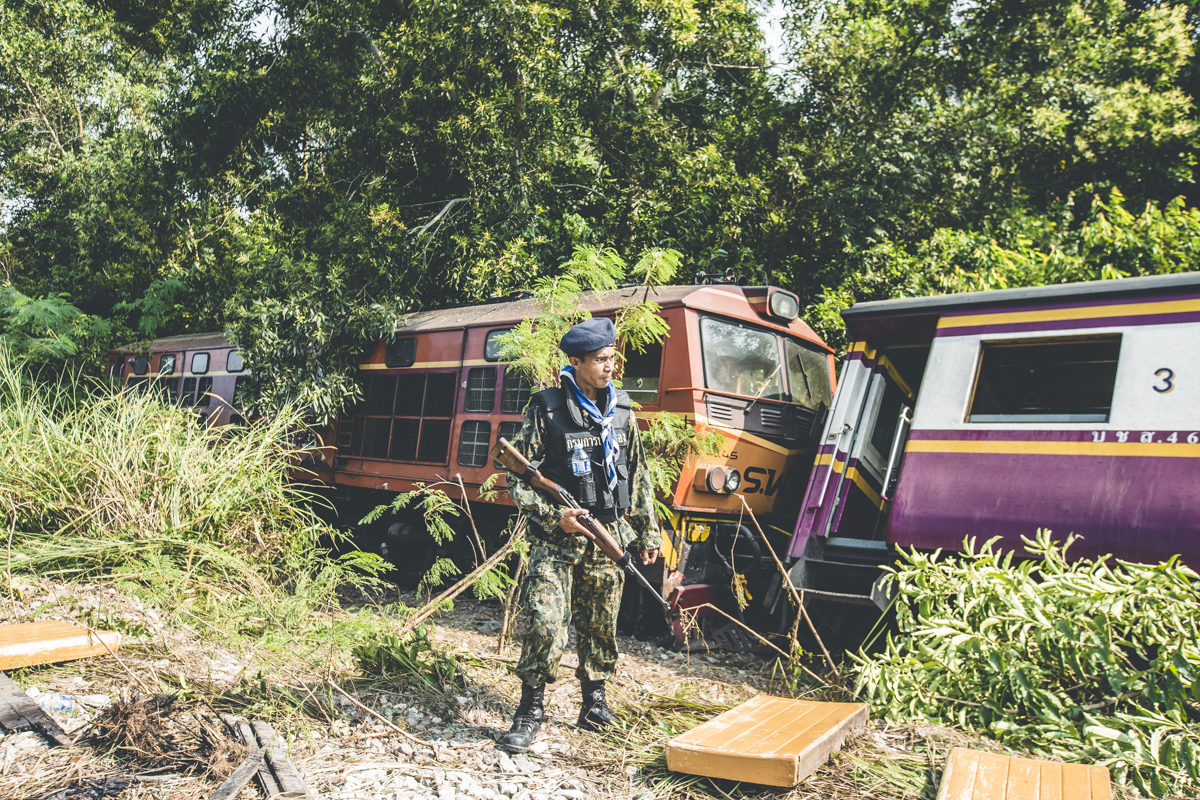
Southern Thai Railways Train No. 452, which plied the route from Sungai Kolok to Surat Thani, lies in the undergrowth after being derailed in an insurgent attack near Chana station. Seven people onboard were injured in the incident. (Richard Humphries/Kingdom’s Edge Project)
In December, three Thai railway workers were killed by a bomb when clearing the wreckage from an earlier bomb that had derailed a freight train. About a year before this, the train was derailed after a bomb attack on the track near Songkhla province.
The number of attacks on the train and connected infrastructure is classified and exact numbers are nearly impossible to come by. According to an article from the Malaysian Star from 2007, “state railway records for the southern region show that since March 2004, insurgents have attacked trains and other railway property and personnel 42 times, causing 24 deaths and 30 injuries.” According to one Thai-language source, the train was attacked more than 100 times between 2004 and 2012. In December 2016, the Bangkok Post reported that since 2004, the train had been hit by insurgents “dozens of times.”
The train is mainly used by the region’s poor, many of whom do not have any other form of transport. It is also used by schoolchildren, as transport to schools in the region is in short supply. The southern provinces are some of the poorest in Thailand and although the vast majority of the passengers on the train are local Muslims, the train has been attacked ceaselessly by insurgents who clearly see it as both an easy target and as a symbol of the Thai state.
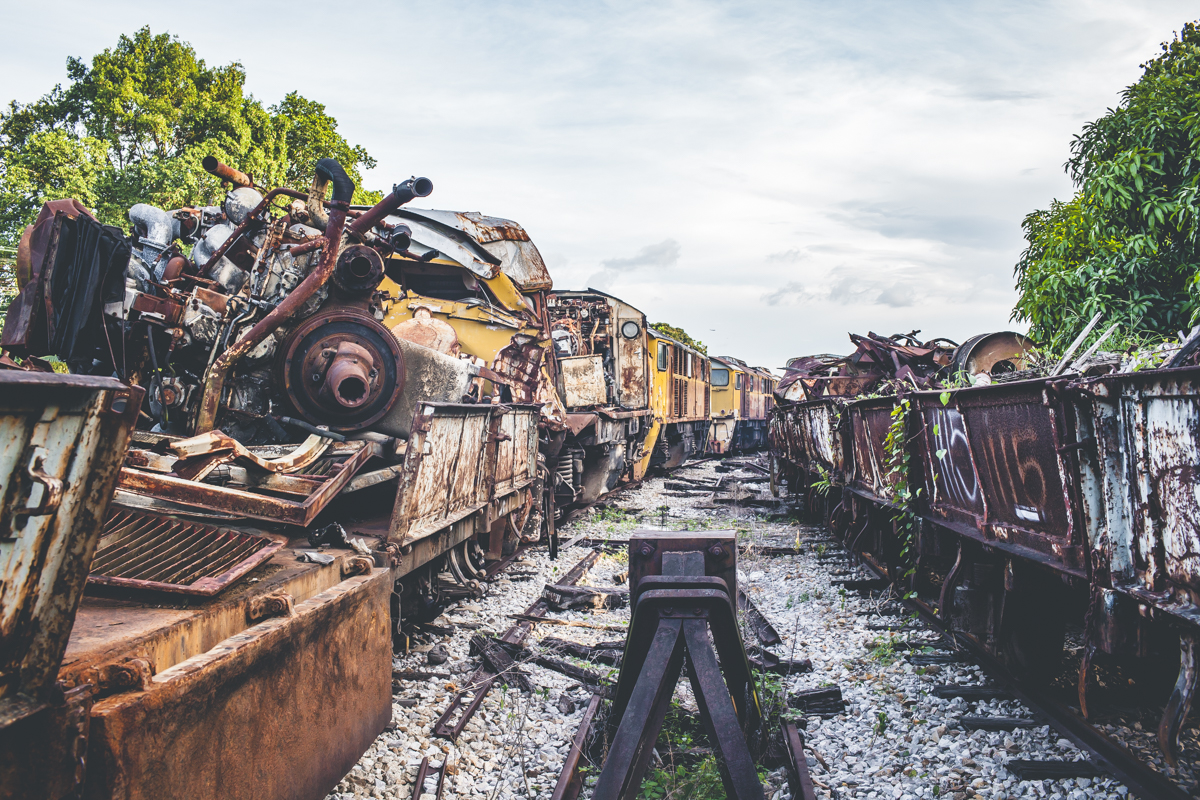
A graveyard of damaged and destroyed Southern Thai Railways locomotives and rolling stock sits in a siding at Hat Yai junction station. All of the wreckage is the result of insurgent attacks. (Richard Humphries/Kingdom’s Edge Project)
The list of incidents is long: In March 2005, the train was derailed after being bombed twice, and then machine-gunned by insurgents hiding in the jungle nearby. In April 2007, numerous passengers were injured after the train was sprayed with machine-gun fire. That June, the train was derailed in Pattani province after parts of the track were removed by insurgents. In June of the following year, three Thai railway employees and a policeman were killed by insurgents in a shooting on board the train as it was moving, and numerous passengers were also injured. In April 2009, the train was again machine-gunned by insurgents, killing one member of a government-sponsored paramilitary organization who was on board.
In July 2011, two different sections of the railway were destroyed by bombs, interrupting rail service for days. In August 2012, the train was machine-gunned by insurgents again, killing a member of a local paramilitary team. Hundreds of spent-casings were later found in a ditch near the railway line. Another attack in 2012, on November 18, involved a bomb placed on the track at Bukit station in Narathiwat. It exploded as the train pulled into the station on a Sunday morning. Three people were killed and 36 injured, while two carriages were derailed and the train itself was very badly damaged by the blast.
For many years, locals could travel on the train for free, but after the military coup in 2014, fares were re-introduced. Since the coup, the train has been attacked during the holy month of Ramadan numerous times, particularly when locals are making their way home to visit their families. It is attacks such as this, targeting essential services such as public transport, local administration, and schools, that have made BRN’s insurgency increasingly less attractive to the local Muslim population over the last two decades.
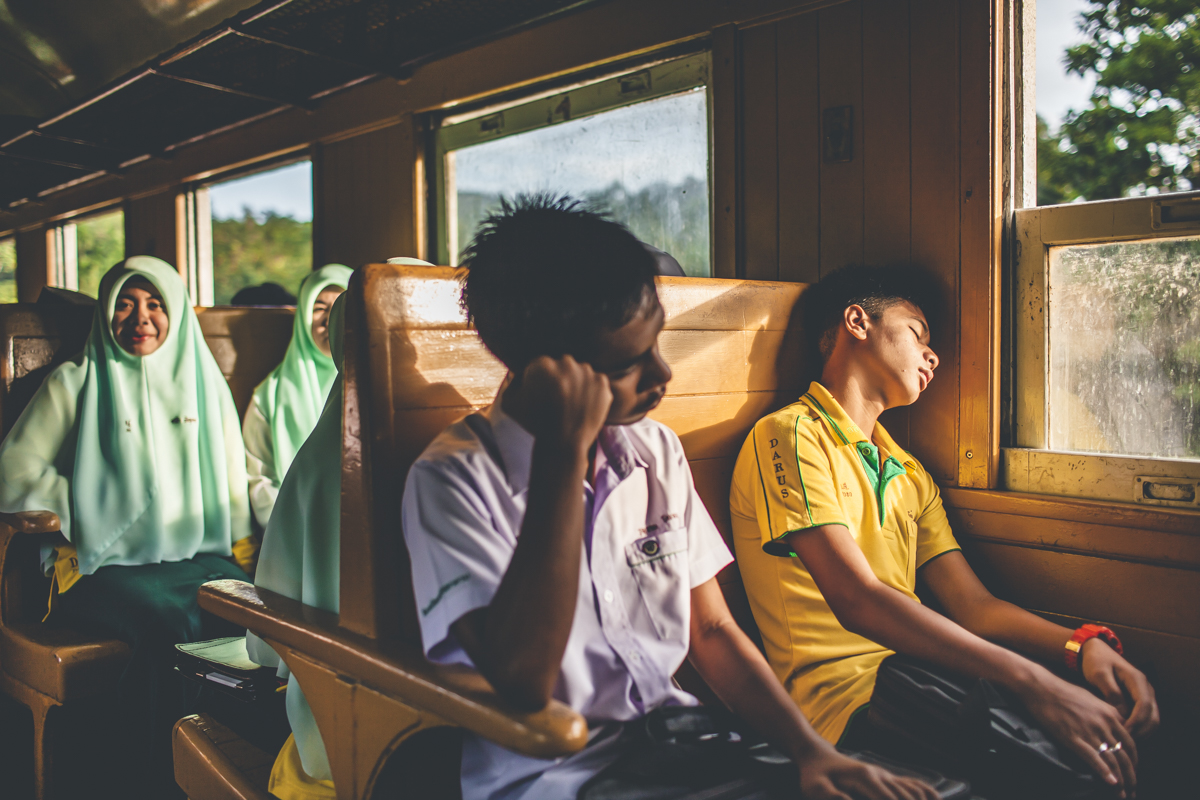
Students from a school in Narathiwat relax onboard Southern Thai Railways Train No. 172, while heading north on their way to school. The train in the Thai deep south is the only means of transportation for many people. (Richard Humphries/Kingdom’s Edge Project)
Despite the constant threat of violence, the journey across the South is exceptionally rich, both visually and socially. The changing landscape of the south, the quaint small towns, the local foods being sold to passengers from the platforms, and encounters with locals along the route, make the journey both novel and exciting. Soldiers and defense volunteers are always on board the train, in addition to providing security for each of the 30 or so stations along the route. The sight of old men playing cards, drinking tea, and smoking rolled-up cigarettes in the carriages is common, as is the practice of selling lottery tickets and Buddhist amulets on board. The train stops in some of the most dangerous districts in the south, such as Raman, Rueso, Rangae, Joh-ai-rong and Sungai Padi, altogether making the train journey between Hat Yai and Sungai Kolok the most dangerous in Southeast Asia, and possibly the world.
The journey begins at Hat Yai Junction, a station that has been bombed repeatedly by insurgents since 1977, during the previous separatist conflict in the south. Departing from Hat Yai Junction and heading south, one immediately sees the “train graveyard,” the wreckage and ruins of old and damaged trains gathered together at the edge of the station.
The train begins to venture through Hat Yai’s run-down boroughs and then out into the thick forests and hills along the city’s edges. Beyond the bustling commercial center and towering hotels of Hat Yai, the train enters the small and seemingly affluent towns of eastern Songkhla province before passing through part of Pattani province. The train stops at small stations in Pattani such as Wat Chang Hai, a beautiful, elaborate Buddhist temple complex that also serves as a makeshift military base for the Thai army, and Khok Pho, a transit point for the province.
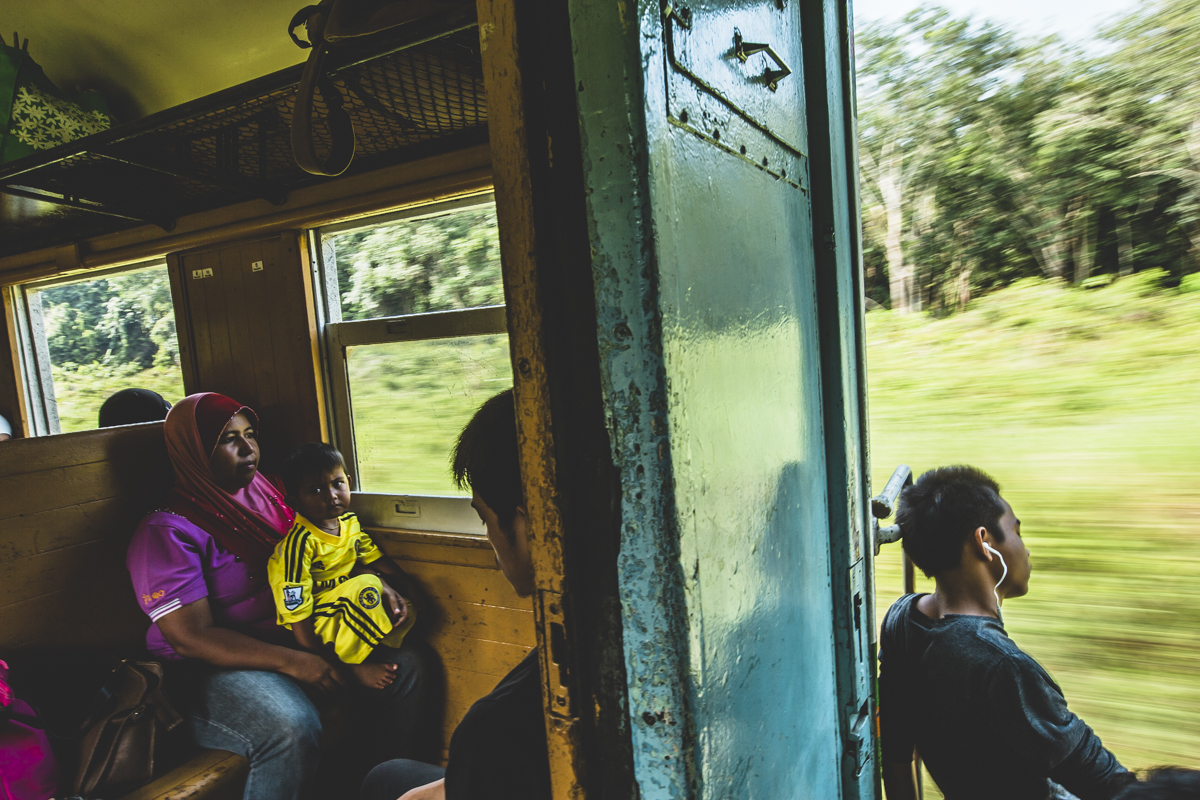
Passengers relax onboard Southern Thai Railways Train No. 447 while heading south to Sungai Golok station on the Thailand/Malaysia border. The train in the Thai deep south is the only means of transportation for many people. It is also free. (Richard Humphries/Kingdom’s Edge Project
The sight of an abandoned Buddhist temple greets the traveler as the train enters Yala and travels past the Muslim old-market district of the city. The temple serves as a reminder of the substantial exodus of Thai-Buddhists from the region over the last two decades. Yala is an elaborately planned city with the appearance of being somewhat segregated along religious lines. Blast walls and roadblocks are scattered around this prosperous yet divided city. After Yala, the line is surrounded by a stretch of lush countryside as the train meanders on toward Narathiwat province.
The second half of the journey is mainly through Narathiwat’s “red zones,” districts that have experienced a high level of violence over the past two decades. Although seen as high-risk areas, the towns are quaint and the stations are well-maintained. As the train passes through the forested hills, one can observe roadblocks, bunkers, and patrols moving throughout the countryside. Reminders such as these of the restive region’s simmering insurgency are constant along the journey, as are the sights of colorfully painted Mosques and fortified Buddhist temples.
The final destination is Sungai Golok, one of Thailand’s cities of vice on the border with Malaysia. Golok is a vibrant bundle of contrasts, from the chaotic and wild center, made up of hotels, bars, and noisy clubs, to the outskirts of the town along the river, where one can find a more authentically Malay way of life. The Golok River, a bustling center of smuggling and illegal border crossing, forms the border between Thailand and Malaysia. Hundreds of Malaysian tourists visit the town each weekend, hungrily seeking out a sample of a kind of nightlife not available south of the border in Malaysia.
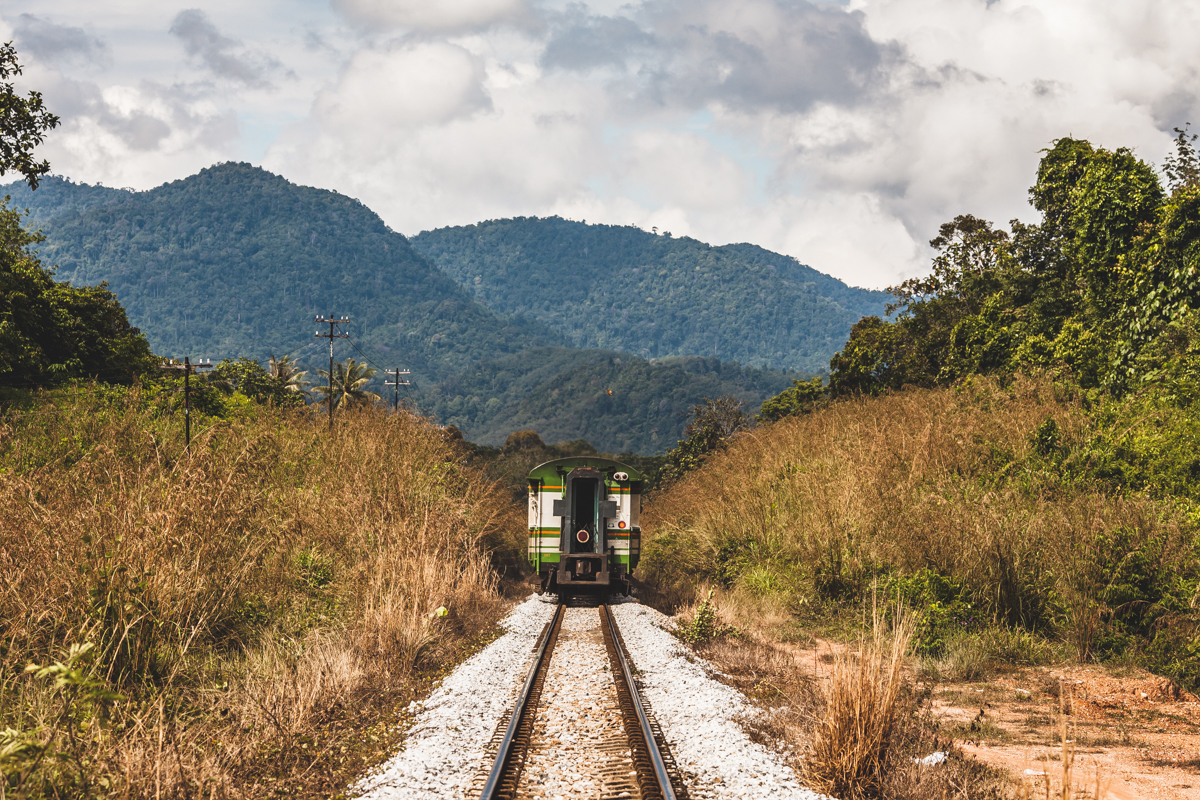
Southern Thai Railways Train No. 172, bound for Hat Yai Junction station from Sungai Golok on the Thailand-Malaysia border, makes its way north towards the lush green Sankalakhiri mountain range. (Richard Humphries/Kingdom’s Edge Project)
It is unlikely that the Insurgency Express will become some type of attraction for Western tourists in the future, due to the region’s geographical isolation and the continuing violence in the southern provinces. Although it is arguably the most besieged railway line in the world, it is also an incomparable journey across a wild and little-known landscape. Despite the history of violence and the continuing strife in the southern provinces, this obscure route is characterized by discovery, beauty, mystery, and enchantment. From the bustling markets of Hat Yai to the misty hills of Narathiwat and onward to the decadent sin-city of Sungai Golok, the journey captures all that is engaging and seemingly inconsistent or contradictory about Thailand’s southern provinces. In its entirety, a journey on the Insurgency Express serves as a type of overview of a unique, complex, and layered region, home to different communities living together, yet separately.













